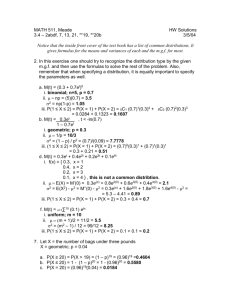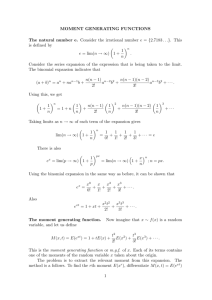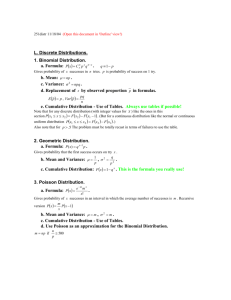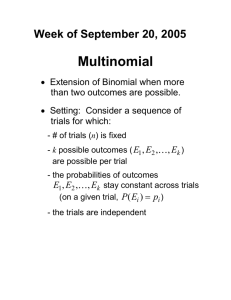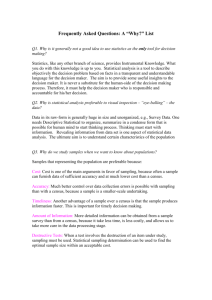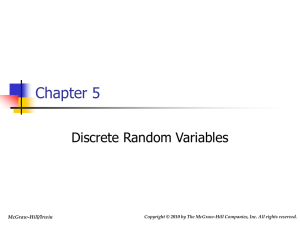Solutions for Moment Generating Function worksheet
advertisement
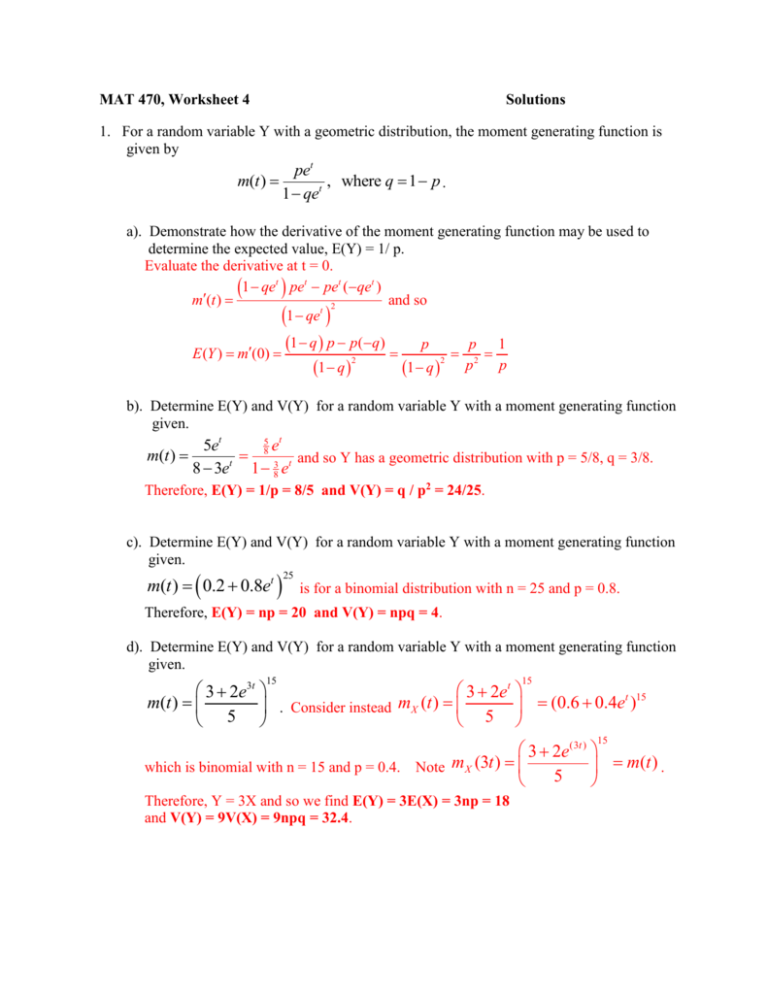
MAT 470, Worksheet 4 Solutions 1. For a random variable Y with a geometric distribution, the moment generating function is given by pet m(t ) , where q 1 p . 1 qet a). Demonstrate how the derivative of the moment generating function may be used to determine the expected value, E(Y) = 1/ p. Evaluate the derivative at t = 0. 1 qet pet pet (qet ) m(t ) and so t 2 1 qe E (Y ) m(0) 1 q p p(q) p 2 2 1 q 1 q p 1 p2 p b). Determine E(Y) and V(Y) for a random variable Y with a moment generating function given. m(t ) 5 t 5et 8e and so Y has a geometric distribution with p = 5/8, q = 3/8. 8 3et 1 83 et Therefore, E(Y) = 1/p = 8/5 and V(Y) = q / p2 = 24/25. c). Determine E(Y) and V(Y) for a random variable Y with a moment generating function given. m(t ) 0.2 0.8et is for a binomial distribution with n = 25 and p = 0.8. 25 Therefore, E(Y) = np = 20 and V(Y) = npq = 4. d). Determine E(Y) and V(Y) for a random variable Y with a moment generating function given. 15 15 3 2e3t 3 2et t 15 m(t ) . Consider instead mX (t ) (0.6 0.4e ) 5 5 15 3 2e(3t ) which is binomial with n = 15 and p = 0.4. Note mX (3t ) m(t ) . 5 Therefore, Y = 3X and so we find E(Y) = 3E(X) = 3np = 18 and V(Y) = 9V(X) = 9npq = 32.4. 2. For a discrete random variable Y with moment generating function given by 10 et 4 m(t ) 5 is binomial with n = 10, p = 1/5, q = 4/5 a). Determine the expected value of Y, E( Y ) = np = 2 b). Determine the expected value E( 3Y 2 + 5 ) = 3E( Y 2 ) + 5 = 3(28/5) + 5 = 21.8 where V(Y) = npq = 8/5 and so E( Y2 ) = V(Y) + (E(Y))2 = 8/5 + 4 = 28/5 c). Determine the variance V( 4Y + 10 ) = 16V( Y ) = 16 (8/5) = 25.6 3. The Poisson probability distribution with = 3, has moment generating function m(t ) e3e 3 . t Its first and second derivatives are given by m(t ) 3et e3e 3 and m(t ) e3e 3 9e2t 3et . t t a). Determine the second moment, E (Y ) m(0) (e 2 b). Compute the third derivative, 33 )(9 3) 12 m(t ) e3e 3 (18e2t 3et ) (9e2t 3et ) e3e 3 (3et ) t t c). Determine the third moment, E (Y ) m(0) (18 3) (9 3)(3) 57 3 4. Consider a discrete random variable with the following probability distribution. x 0 2 4 6 p(x) 0.4 0.3 0.2 0.1 a). Construct the moment generating function m( t ) for this random variable. m( t ) = E( etx ) = e0(0.4) + e2t(0.3) + e4t(0.2) + e6t(0.1) = 0.4 + 0.3e2t + 0.2e4t + 0.1e6t b). Using the derivative, compute the expected value E(X) = m’(0) = m’( t ) = 0.6e2t + 0.8e4t + 0.6e6t and so E(X) = m’( 0 ) = 0.6 + 0.8 + 0.6 = 2.0. c). Compute the expected value using the definition, E ( X ) x p( x) 0(0.4) + 2(0.3) + 4(0.2) + 6(0.1) = 2.0, as above. x 5. Let Y be a random variable with mean 16. Based on Tchebysheff’s theorem, P(| Y | k ) 1 . k2 a). Find the value of k such that we’re guaranteed P(| Y 16 | k ) 0.16 Here, let k2 = 1/.16 and so k = 2.5. b). Suppose this is actually a Poisson distribution with mean 16. Determine the interval | Y 16 | k , using the value of k from part “a”. For Poisson, V(Y) = E(Y) = 16 and so the standard deviation is 4. The interval 16 – 2.5 < Y < 16 + 2.5 is the interval ( 6, 26 ). 6. Let Y be a binomial random variable with n = 100 and p = 0.03. Based on Tchebysheff’s 4 , but this is just an upper bound. For this particular 9 distribution, determine the actual probability P(| Y | 1.5 ). Since V(Y) = npq = 2.91 and = E(Y) = np = 3, the interval 1.5 Y 1.5 theorem P(| Y | 1.5 ) is the interval 3 1.5 2.91 Y 3 1.5 2.91 or simply (0.44, 5.56). For this binomial distribution, P( 0.44 < Y < 5.56) = P(Y = 1) + … + P( Y = 5) = 0.8716. Therefore, the complement P(| Y | 1.5 ) = 1 – 0.8716 = 0.1284 is indeed less than 4/9, as promised.
